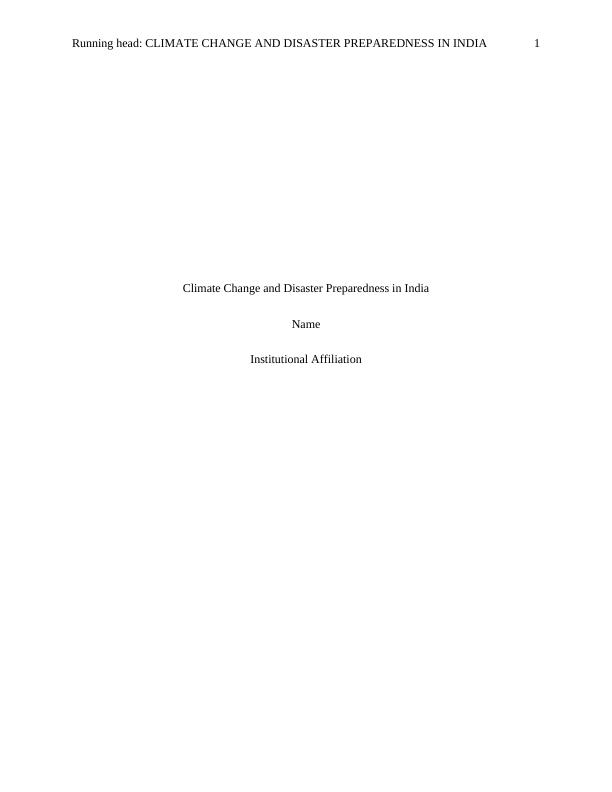Climate Change and Disaster Preparedness in India
Added on 2023-05-30
4 Pages788 Words198 Views
Running head: CLIMATE CHANGE AND DISASTER PREPAREDNESS IN INDIA 1
Climate Change and Disaster Preparedness in India
Name
Institutional Affiliation
Climate Change and Disaster Preparedness in India
Name
Institutional Affiliation

CLIMATE CHANGE AND DISASTER PREPAREDNESS IN INDIA 2
The most recent climate changes in India reveal that it is the ideal time to stop using
fossil fuels and avoid all the technologies that could alter the climate (Pathak, Pramanik, Kumar,
& Khanna, 2015). Critically, climate change is the most serious environmental challenge facing
not only India but the entire plant today. The earliest action is required to save the ecological
biodiversity and avert all the threat that climate change poses to the habitats of all living
organisms. Essentially, when the ecosystem is altered, the people’s livelihoods are usually
exposed to much danger. An entire energy revolution is required whereby the planet will be
moving from nuclear and fossil generated fuels to renewable energy sources. The effect of
human activity on the environment is much evident in India. Fortunately, the country already has
alternative and proven energy sources that will ensure sustainable development. However, the
shift from non-renewable energy has proved to be rather challenging and could be delayed. This
calls for disaster preparedness if the country is to survive the turbulence occasioned by climate
change.
Primarily, climate change is expected to lead to a rise in both the frequency and intensity
of the harsh weather conditions (Mall, 2015). Additionally, there is much likelihood that climate
change will bring forth new disasters and vulnerabilities with varied socio-economic effects to
the Indians. Particularly, the impact will influence the resilience of the susceptible communities
and the poor which make up a considerable percentage of the Indian population. The increased
processes of land development coupled with rapid industrialization and agricultural practices
increase the risk of climate change. People settled in vulnerable zones are left with no choice but
migrate to alternative areas which are already overpopulated. The hydrological system in India
has been highly modified consequently resulting in the fall of the water table.
The most recent climate changes in India reveal that it is the ideal time to stop using
fossil fuels and avoid all the technologies that could alter the climate (Pathak, Pramanik, Kumar,
& Khanna, 2015). Critically, climate change is the most serious environmental challenge facing
not only India but the entire plant today. The earliest action is required to save the ecological
biodiversity and avert all the threat that climate change poses to the habitats of all living
organisms. Essentially, when the ecosystem is altered, the people’s livelihoods are usually
exposed to much danger. An entire energy revolution is required whereby the planet will be
moving from nuclear and fossil generated fuels to renewable energy sources. The effect of
human activity on the environment is much evident in India. Fortunately, the country already has
alternative and proven energy sources that will ensure sustainable development. However, the
shift from non-renewable energy has proved to be rather challenging and could be delayed. This
calls for disaster preparedness if the country is to survive the turbulence occasioned by climate
change.
Primarily, climate change is expected to lead to a rise in both the frequency and intensity
of the harsh weather conditions (Mall, 2015). Additionally, there is much likelihood that climate
change will bring forth new disasters and vulnerabilities with varied socio-economic effects to
the Indians. Particularly, the impact will influence the resilience of the susceptible communities
and the poor which make up a considerable percentage of the Indian population. The increased
processes of land development coupled with rapid industrialization and agricultural practices
increase the risk of climate change. People settled in vulnerable zones are left with no choice but
migrate to alternative areas which are already overpopulated. The hydrological system in India
has been highly modified consequently resulting in the fall of the water table.

End of preview
Want to access all the pages? Upload your documents or become a member.